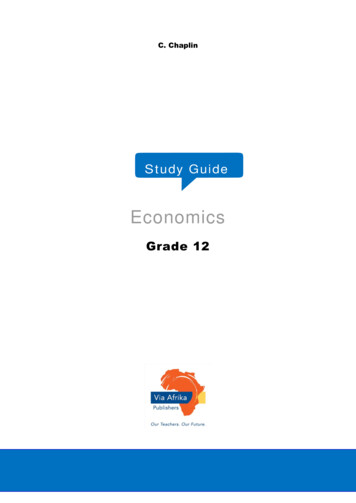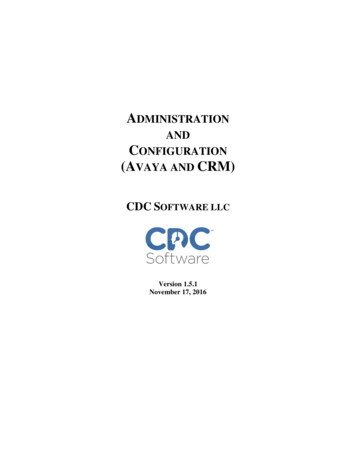
Transcription
C. ChaplinBusiness StudiesGrade 111
ContentsIntroduction to Business Studies5Term 1Introduction6Topic 1Influences on the business environments7Questions and answers12Challenges of the business environments15Questions and answers23Adapting to challenges of the business environments26Questions and answers34Contemporary socio-economic issues37Questions and answers42Business sectors44Questions and answers48Benefit of a company over other forms of ownership50Questions and answers62Avenues of acquiring a business67Questions and answers74Topic 2Topic 3Topic 4Topic 5Topic 6Topic 72
Term 2Introduction77Topic 1Creative thinking and problem-solving78Questions and answers85Stress and crisis management87Questions and answers93Transforming a business plan into an action plan94Questions and answers98Topic 2Topic 3Topic 4Topic 5Topic 6Setting up or starting a business100Questions and answers104Professionalism and ethics105Questions and answers108Presentation of a business plan109Questions and answers115June exam and memo117Term 3Introduction132Topic 1Entrepreneurial qualities and success factors133Questions and answers136Citizenship roles and responsibilities137Questions and answers141Topic 23
Topic 3Topic 4Marketing function143Questions and answers166Production function168Questions and answers174Term 4Introduction176Topic 1Team dynamics and conflict management177Questions and answers184Introduction to human resources186Questions and answers195Topic 2November exam and memo1974
Why Business Studies?Business Studies is an important subject to study when you would like to follow a career inbusiness management, finance, administration or marketing. Business Studies will also help youwith many areas of your life and with whatever career you would like to pursue.Business Studies will help you to: analyse the impact of changing and challenging environments on business practices,e.g. the increasing fuel price and the impact it has on businesses worldwide; devisingstrategies to cope with these challengesdesign and use a research instrument to assess needs and wantsencourage creative thinking to generate entrepreneurial opportunities, e.g. opening an icecream stall on Margate beach during peak seasonprocess and analyse data for decision makingdevelop an action plan from a business planunderstand the legal implications of contactsunderstand the implementation of the employment equity act and labour lawsdemonstrate and apply a range of management skills in all eight management functions:purchasing, production, financial, marketing, public relations, human resource management,information management and general managementIt is an exciting subject – focused on your future! Business Studies will help you to plan ahead andto maintain a good work ethic. This means that you are going to have to work quite hard but notwithout rewards.This Study Guide eBook was designed to help you to reach your goals for Business Studies. It issummarised in point form to make it easier for you to memorise. An effective way to use the StudyGuide is by using it together with the SQ3R study method:SStudyUse this Study Guide to get to know your work. Study small sections at atime and then continue to the next section. Use mindmaps and othervisuals to make it easier for you to remember your work.QQuestionsAfter every topic, there are questions that you can use to test yourknowledge. Make sure that you can answer all of these questions.RReadOff course there will be questions that you will not be able to answerimmediately. Go back to these sections and read them again.RRecallCheck to see if you can recall the answers of questions you were unable torecall before.RReviseIt is important for you to revise. Have a look at your summaries again. Thiscan be done early the morning before you write your exam or test.We hope you will enjoy this Study Guide and that it will help you to pass exams.Aim for success!The Author5
Term 1 IntroductionTopic 1 Influence on the business environmentsTopic 1 introduces you to the influence the business has over its businessenvironments.Topic 2 Challenges of the business environmentsTopic 2 gives an overview of the challenges that arise from the differentenvironments. The challenges are linked to the different elements of themicro, market and macro environments.Topic 3 Adapting to challenges in the business environmentsTopic 3 deals with ways a business can adapt to challenges in the internal andexternal environments. This depends on the control or influence the businesshas over the environment (Topic 1) and how serious and complicated thechallenges are (Topic 2).Topic 4 Contemporary socio-economic issuesTopic 4 deals with the impact of contemporary socio-economic issues on thebusiness and productivity. The topic also investigates the developments ofindustrial relations that relate to existing business practice. These includeindustrial action such as strikes, lock-outs and go-slows, as well as the history,role and functions of trade unions.Topic 5 Business sectorsTopic 5 introduces you to the different sectors of the economy: primary,secondary and tertiary, as well as to the links between these sectors.Topic 6 Benefit of a company over other forms of ownershipTopic 6 describes the benefits of forming a company over other forms ofownership. In Grade 10 you were introduced to the range of legally recognisedforms of business ownership. In this topic, these various forms of ownershipare described in greater detail, comparing them directly with each other interms of their ownership, structure and legal requirements.Topic 7 Avenues of acquiring a businessTopic 7 introduces you to different ways to acquire a business. The two basic waysare starting a new business or buying an existing business. These are extended bythe options of franchising, outsourcing and leasing of assets. The advantagesand disadvantages of the different options are explained.6
Topic 1 Influences on businessenvironmentsOverview The micro, market and macro environment affect each other. Anything that can change in theenvironment is called a variable.The enterprise has most control over the micro environment, less control over the marketenvironment and even less control over the macro environment.It is beneficial to the enterprise to be involved in the macro environment.the variables occurin all threeenvironmentsInternal (Micro) Environment mission objectives management structure resources culture ExternalEnvironmentThe business environmentWays that the business can beinvolved in the macroenvironmentMarketEnvironment customers suppliers competitors regulators intermediariesMacro Environment Socioeconomic Legal Technological Political Institutional(government) Economic International Physical7
1. Control factors in the business environments.The business environment is made up of all those variables that can influence the survival of anorganisation.These variables are divided into: The micro environmentThe market environmentThe macro rnalenvironment The internal environment consists of the micro environment of the businesses that is theactual business itself.The external environment consists of the market and macro environments of the business.The market environment is its operating environment and the macro environment is thegeneral environment surrounding the business.1.2 Factors in the environments that affect the organisation.External EnvironmentInternal (Micro) Environment Vision, mission and goalsBusiness structureFactors of productionBusiness functionsManagement styleEmployeesBusiness ethicsOwnersBusiness policiesMarket Environment 8Macro Environment onal (government)EconomicInternationalPhysical
2. Characteristics of the business environment. The business environment is made up of many parts.All the parts are interdependent and interrelated.The business environment is uncertain and unstable and can vary from time to time.The business environment is dynamic and unstable. Businesses must be prepared to be bothproactive and reactive, they must adapt to changes.Changes in the business environment can affect different businesses in different ways; achange can be positive for one business and negative for another.Changes in the business environment can have both short term and long term effects on abusiness.The external business environment can have a huge impact on a business that it must adaptto in order to survive. For example the current global recession.The business environment is complex and it is difficult for entrepreneurs to determine riskfactors.2.1 The control of the business over the business environment.2.1.1 The Micro EnvironmentControl of the micro environment is achieved by using internal control systems. These aim to: Enable management to make sure that the objectives of the business are met.Make sure that reliable financial statements are prepared.Check that the business complies with all applicable laws and regulations.Controllable variables are: The mission, mission and goals of the firm.The firm's business structure.The organisation and use of factors of productionThe organisation of the eight business functionsThe management styleManagement of employeesChoice of business ethicsType of ownershipImplementation of business policiesAspects of internal control: Controlling the philosophy and values of the businessCreating efficient information and communication systemsMonitoring performanceAssessing riskControlling the activities of the business9
philosophy andvaluesrisk assessmentInternal controlinformation andcommunicationscontrol of activitiesperformancemonitoring2.1.2 The Market EnvironmentThe business needs to be aware of the opportunities and threats in the market environment becausethese will affect its success or failure.Opportunities include: Understanding the customer and their needs Making use of trade discounts Finding cheaper services or suppliers Making use of market research to create higher sales Creating a positive public imageThreats include: Lack of customer loyalty Increase in the cost of raw materials Unrest among workers Price wars Failure to lobby government.The business has limited control over the market environment. The market environment can bedivided into four main areas: Customers Suppliers and intermediaries. Competitors Civil SocietyOpportunities and threats in the market environmentOpportunitiesThreatsCustomersCreating customer loyaltiesLack of customer loyaltySuppliersPossibility of trade discountIncrease in cost of raw materialsIntermediariesAlternative or cheaper servicesUnrest amongst workersCompetitorsMarket research and higher salesPrice warCivil SocietyPositive public imageNegative public image10
2.1.3 The macro-environmentThe business has no control over the macro environment but can control how it reacts to challengesin the macro environment.Examples of areas of the macro environment include the following: Physical environmentEconomic environmentThe socio-economic environmentLegal environmentTechnological environmentPolitical environmentInstitutional (government) environmentInternational environment11
3. Ways that the business can be beneficially involved in the macroenvironment.By being positively and actively involved in the macro environment, businesses can improve theeconomic and social conditions within South Africa.Ways in which the business can be involved in the macro environment: Collective bargaining or lobbying to improve working conditions or change governmentregulations.Private-public partnerships, such as crime watches or social upliftment.Privately owned services for the community or country such as schools or water supply.Job creationSocial responsibility initiativesGovernment tenders to bid for large state contracts.Expansion into other African countries to create export markets and more jobs.Improving technology to streamline economic growth.End of topic questionsMultiple ChoiceSelect the correct answer from the alternatives.1. The marketing function of Gizmo Toys (Pty) Ltd would be part of the .environment.A. MicroB. MarketC. MacroD. Internal(2)2. A change in the immigration policy of the country would take place in the.environment.A. MicroB. MarketC. MacroD. Business3. Which of the following is NOT a characteristic of an entrepreneur?A. The need for achievementB. Focus of controlC. Propensity for risk-takingD Ability to solve problems(2)(2)True or FalseAnswer only true or false.4. The market environment is always under the control of the business.12(2)
5. Making sure all employees are trained to do their jobs properly is part of the micro environment.(2)6. Variables such as changes in Employment Laws do not affect the business because they arebeyond the control of the business.(2)Short questions7. Explain the meaning of the micro business environment.8. Make a list of 5 variables (challenges) of the micro business environment.9. Describe the market business environment and name 4 variables (challenges).10. List four parts of the macro environment.(6)(10)(10)(8)Essay Question.11. Responsible businesses become actively involved in their macro environment. Discuss thisstatement and suggest ways that businesses can be positively involved in the economic structure ofthe country.(40)End of topic answers1. B(2)2. C.(2)3. C.(2)True or False4. F5. T6. F(2)(2)(2)Short questions7. Consists of the business itself and is controlled by management. The business can control thevariables in this environment. (6)8. (any 5 x 2 10) Vision, mission and goals Business structure Factors of production Business functions Management style Employees Business ethics Owners Business policies (10)9. Consists of suppliers, customers and competitors. (2) Lack of customer loyalty Increase in the cost of raw materials Unrest among workers Price wars Failure to lobby government. ( any 4 x 2 8)(10)13
10. Physical environment Economic environment The socio-economic environment Legal environment Technological environment Political environment Institutional (government) environment International environment ( any 4 x 2 8)[8]Essay Question.11.The business has no control over the macro environment but can control how it reacts tochallenges in the macro environment. Examples of areas of the macro environment include the following: Physical environment Economic environment The socio-economic environment Legal environment Technological environment Political environment Institutional (government) environment International environment (20)By being positively and actively involved in the macro environment, businesses can improve theeconomic and social conditions within South Africa. Ways in which the business can be involved in the macro environment: Collective bargaining or lobbying to improve working conditions or change governmentregulations. Private-public partnerships, such as crime watches or social upliftment. Privately owned services for the community or country such as schools or water supply. Job creation Social responsibility initiatives Government tenders to bid for large state contracts. Expansion into other African countries to create export markets and more jobs. Improving technology to streamline economic growth. (20)[50]14
Topic 2 Challenges of the businessenvironmentOverview This topic examines the challenges that exist in the micro, market and macro businessenvironments. Businesses need to be aware of the challenges they will face in the differentenvironments in order to be able to deal with time and make provision for problems.Anything that can change in one of the business environments is called a variable. Thevariables in the internal and external environments are inter-related because a change in onevariable can affect other variables.The Topic deals with: Challenges of the micro environment, such as lack of vision, poor management, strikes and goslows. Challenges of the market environment, such as competition, supply problems and changes inconsumer behaviour. Challenges of the macro environment such as legislation, globalisation and socio-economicissues.Challenges of thebusiness environmentMicro Environment EmployeesThe goals(vision and mission andbusiness objectives)The form of ownershipThe organisational structureThe management philosophyand styleMarket EnvironmentThe Macro Environment rismSubstitute products15 The international environmentThe legal and politicalenvironmentThe physical environmentThe economic environmentThe governmental environmentThe technological environmentThe political environmentThe social environmentThe institutional environment
1 Challenges of the micro-environmentA challenge in the micro environment refers to variables within a business such as labour and rawmaterials, finance and assets that managers/owners have to manage effectively. EmployeesWorkers need to be properly trained, motivated and have the skills needed to produce high qualitygoods and services. Business owners must ensure that their workers receive adequate skillstraining and education in terms of their particular type of work.The Employment Equity Act ensures that equal employment opportunities are a legal requirementwhen businesses are seeking new recruits. The goals (vision and mission and business objectives)Vision refers to how you see the future or long term goals of the business. Managers and workerswho lack vision and mission are not aware of, or do not understand, the aims of the business andcontributions to the communities that they serve. The form of ownershipThe owners must choose a suitable form of ownership in order to run their business effectively. The organisational structureThe organisational structure determines how a business is managed. The management philosophy and styleThe management philosophy and style determines how effectively a business will be run. Itincludes the core values, convictions and social customs of the business.Three components that contribute to the future vision of the business.The core purpose – The reasons for starting and running the business.The core values – The guiding principles that are important to the business, such as producing thehighest quality products possible.The mission – This is a statement of the businesses' aims and values. Strikes, go slows and trade unionsA strike is when workers refuse to go to work because of disagreements with management orowners of a business. A go slow occurs when workers work slowly and refuse to do anythingextra or work overtime.Trade unions are labour organisations. Today, most workers belong to unions and when they aredissatisfied with wages, working conditions or any other grievances they organise strikes whichimpact negatively on productivity and the smooth running of a business.16
Collective bargainingCollective bargaining occurs when groups or their representatives seek to negotiate with andinfluence employers on matters relating to issues in the workplace. Collective bargaining can helpto stabilise relationships between managers and workers and provide a useful forum for thediscussion of wider issues concerning the progress of the businessLEGISLATION TO CONTROL EMPLOYER/EMPLOYEE RELATIONSHIPS IN SOUTH AFRICA.These are the main laws which regulate employer-employee relations. The Labour Relations ActThe Basic Conditions of Employment ActThe Employment Equity ActThe Occupational Health and Safety ActThe Skills Development Act17
2 Challenges of the Market EnvironmentThe market environment is part of the external or macro environment.2.1 CustomersCustomers have buying power and are in a position to choose with what or where they satisfy theirneeds. A business should aim to create customer satisfaction and aim to retain long-term customerloyalty. This can be done by market research to establish the needs of the target market anddetermine the correct product ant the correct price. The target market is that sector of consumers atwhich a specific good or service is aimed.2.2. SuppliersSuppliers are individuals or businesses that supply inputs such as raw materials, capital, labour orservices (e.g. transport) to a business. These inputs can also be called factors of production.Suppliers need to be reliable. Challenges include ensuring the availability and continuity of suppliesas well as the correct quality and price of supplies.2.3 IntermediariesIntermediaries are also called middlemen and include wholesalers, retailers, agents, insurers,advertisers, etc. Intermediaries operate in the tertiary sector of the economy. They usually pass on orresell products and services. Wholesalers are such as Makro and Trade Centre are large resellers.Agents also pass on goods and services, for example official resellers of spare parts for cars.Insurance brokers sell insurance on behalf of insurance companies such as Old Mutual.The following challenges may be present: E-commerce, allowing consumers to buy direct from the InternetLarge retail groups can out price smaller shopsLarge retailers offer own name brands at cheaper pricesConsumer protection laws help consumers to manage their debtServices provided by intermediaries can increase the costs of a product2.4 CompetitorsCompetitors are businesses that sell similar or substitute products. Businesses face a challenge intrying to make their products different or more desirable. Competition is an important part of the freemarket system. The small business owner needs to know as much as possible about competitors inthe same business. They must gauge the strengths, weakness and advantages of the competitionand use that knowledge to better their own business.Challenges relate to: Industry rivalryNew entrants to the marketCheaper or better substitutesThe bargaining power of suppliersThe bargaining power of customers and clients18
The availability of substitute productsThe possibility to copy or duplicate a product2.5 ConsumerismConsumerism refers to the organised actions of consumer groups and the government to protectconsumer rights. The Consumer Protection Act aims to protect consumers against unethical practicesand products that represent a danger to health or safety.Businesses are challenged to: act ethically and responsiblybe socially responsiblebe aware of environmental issuestreat customers fairly2.6 Regulators and Trade UnionsRegulators are government bodies that oversee specific aspects of business such as health andsafety. A good relationship with trade unions ensures a good relationship with the business'workforce.2.7 Strategic AlliesWhen two or more businesses work together in a joint venture they are strategic allies. This helps abusiness to obtain from another business some expertise which they may lack.19
3 Challenges of the Macro Environment.There are many factors in the macro environment that can influence the growth of the business.These factors cannot be controlled and are difficult to predict or avoid. Examples include: The economic recessionGovernment regulations and lawsClimate changeThe impact of HIV/AidsPolitical changesChanges in consumer tastes3.1 Factors in the macro environment1. International/Global8. Social7. Political2. LegalThe MacroEnvironment6. Technological3. Physical4. Economic5. Institutional/Government20
The international environment International trade is a challenge in terms of the massive and diverse products that are nowglobally available to many countries. Multinational companies affect the macro environmentthroughout the world.Cheaper imported goods are a major challenge to local suppliers and producers. Localbusinesses that cannot compete with imports could have to close down. Workers will losetheir jobs.Dumping – Goods that are exported at extremely low prices by countries wishing to establisha market.All countries gain from international trade bringing greater competition, greater choice andgreater specialisation.A disadvantage to a country restricting international trade is that other countries ‘follow suit’,with the risk of a trade war and an inevitable economic recession.Tariffs – paid to the government. Also called import duties which raise the price of imported goods,making it less competitive to local manufacturersSubsidies – are given by the government to local producers which make their goods cheaper andtherefore more competitive than those from importers.The legal and political environment1. South Africa has a new constitution.2. The laws of the country ensure that citizens and businesses are protected and serve as moraland ethical guidelines where no others exist.3. Sometimes the law is restrictive to business owners. Example: the new National Credit Lawno. 34 of 2005 came into effect on 1 June 2007 to regulate the credit industry and enforceresponsible credit lending.4. Black Economic Empowerment (BEE) is an economic policy targeting inequality in theworkplace and aimed at broadening the economic base of the country.The physical environment5. The physical environment means the natural resources available both locally andinternationally. Natural resources are not always infinitely available and measure need to betaken to protect and preserve them.6. Scarce resources or raw materials lead to higher costs and higher prices. Examples: water,energy, mining, fishing, agriculture, foods.Physical environmental issues such as pollution and depletion of scarce resources can be very costlynot only to business but also to the many people and animals on the planet. Factors such as globalwarming and the depletion of the ozone layer have forced many governments to pass laws to controlemissions of harmful substances.Businesses can RE-USE products, for example glass bottles, RECYCLE used products, for examplerubber products or REDUCE wastage by ensuring that all of the raw materials are used in some way21
The economic environment South Africa has a mixed market economy which means it has both privately andgovernment owned business.The economic cycle involves the flow of money and products (including services) in oppositedirections. People have to satisfy their needs and wants. They do this by paying privatelyowned businesses or parastatals (partly owned government institutions) for goods andservices.Some of the main economic factors in South Africa are inflation, globalisation, unemploymentand interest rates.The governmental environment South Africa has a mixed market economy where the government ensures that the nation isprovided with essential goods and services such as health, education, safety and transport.Government institutions need to be reliable and consistent in their standards and delivery.The state also implements programmes such as GEAR (Growth, Employment andRedistribution), the RDP (Reconstruction and Development Programme) and the IDC(Industrial Development Programme to try and create economic growth.The technological environment Business owners must be aware of what technological advances are taking place within theirown industries. New technology could make your production methods obsolete (outdated). Businesses must make sure they have the capital to replace old equipment. Businesses must use or create training and skills programmes to keep workers up to date. The internet is an example of technological change.The political environment South Africa has undergone many since 1994.Many more people have access to education, financing and self-improvement than everbefore.Jobs are not restricted to specific genders or groups.The large number of unskilled people in the job market is a problem.Some policies that pose a challenge to business owners such as affirmative action, BlackEconomic Empowerment and the tax implications on some products.The social environmentSouth Africa is faced with major social challenges. Some of them are: HIV/AIDS is a disease that affects the productivity of not only the employee but also thebusiness owner.Having too many illiterate people in some of our provinces hampers production and servicedeliveries.Diversities in lifestyles, social values, religions, traditions, cultures and habits of consumerscan lead to challenges.Unskilled workers who need training.22
The institutional environment Banks, municipalities, trade unions and government departments all represent a challenge tobusinesses. Micro-lending is a form of credit available to people and small businesses whowould not normally qualify for credit from the larger financial institutions.End of topic questionsMultiple Choice1. The micro environment of a business consists of:A. The firm's mission and objectives; the organisation and resources.B. The firm's mission; the objectives and resources.C. The resources of the business including its customers and organisation.D. The firm's market; its resources and mission.(2)2. Multinational companies:A. Affect the global economy.B. Are a problem in the developed world.C. Restrict the effects of dumping.D. Are part of the internal environment of a business.(2)3. Import duties:A. Lower the price of imported goods making them more available for consumers.B. Encourage international trade.C. Do not apply in South Africa.D. Increase the price of imported goods, lowering consumer demand for them.(2)True or False4. South Africa has a mixed market economy.5. A substitute product is a product that can be used in place of another similar one.6. Resellers form a part of the macro environment.(2)(2)(2)Short Questions7. There are many
business management, finance, administration or marketing. Business Studies will also help you with many areas of your life and with whatever career you would like to pursue. Business Studies will help you to: analyse the impact of changing and challen










